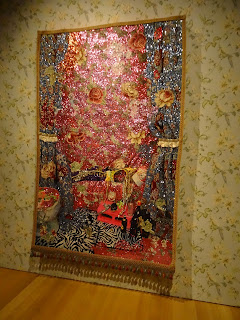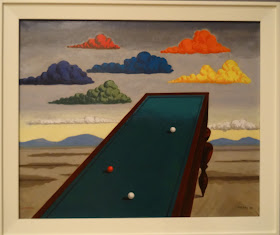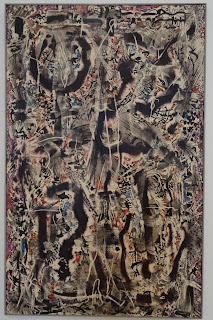That's me, of course, above. The artwork is by Ricci Abenda, and, yeah, I suppose it makes me think. But more about that later...
So hubs and I had plans to walk across the Brooklyn Bridge, but we scrapped the plan till the next day because the weather wasn't good, and instead decided to see the new Whitney Museum, which moved 9 months ago to a completely new location. A bonus to those of you who (in better weather) like to walk in NYC - the new museum is easy access from the south end of the High Line, which is a former elevated rail line converted into a wonderful walking park. We did however, walk the Bridge the next day, and the beautiful structure made me understand why there are so many works of art based on this bridge. Here are two that we saw in the Whitney. The first, "Brooklyn Bridge", is by Joseph Stella, and the second, called "Region of Brooklyn Bridge Fantasy", is by John Marin. Tune in, in a couple of days, for my photos of this iconic bridge!


But anyhoo - the Whitney Museum's collection is American art, and the galleries are set up by era/theme. Below is Railroad Sunset by Edward Hopper. I love the quiet, lonely sense of peace of this painting.
I was struck by a number of images that I thought would be fabulous for teaching perspective, and combining it with surrealism. It doesn't always have to be a Dali!!
Above is The Subway by George Tooker; directly below is No Passing by Kay Sage.
Below, La Fortune by Man Ray.
There are some outdoor decks where you can view the city. In one direction you'll see Lady Liberty, and in the other direction, this. It was too cold and windy to stay out for more than a moment.
I liked seeing this David Smith sculpture "Hudson River Landscape". Smith was from Bolton Landing, on Lake George, just 1/2 hour north of my home. This piece was based on drawings he did looking out the train window, riding along the Hudson to NYC. We took the train to/from NYC so I totally 'get' this piece.
This large piece, below, really intrigued me. By Alfonso Ossorio, it is called Number 14, and is done with layers of wax and ink, using the wax as a resist, and then scraping off, and repeating, creating an intriguing layered piece.
And then, of course, is the marvelous (but hard to photograph) Calder's Circus. Here's a tiny sampling. The whole thing is such a joy, and I think is a great lesson inspiration. You don't have to have fancy sophisticated materials to make art that people will love.
Now here's where things got a little dicey in the museum. My husband tries to be kind, but his immediate response was "Get me some lockers. I'd be happy to crush them for you." Yeah....
And then there were these sinks, "The Ascending Sink" by Robert Gober. It's a couple of sinks, screwed to the wall...
And the painting at the top of the post, and this, below, by Richard Prince. It seems every visit to a major museum has us scratching our heads in at least one room.
Then we came across this., also by Robert Gober (the sink guy). I ended up in a conversation with another museum patron, trying to puzzle it all out. The tag calls it "Newspaper" and for medium, lists it as "photolithographs with twine". It is a pile of newspaper. Now, it happens that, coincidentally, the big headline, from 1992, happens to be about lead in the drinking water, making this very timely, at the moment. But still, the question is, what makes something "art".


It is certainly a definition that is changing, though I am still hung up on the concept (whether or not, on this particular piece) the headline happens to timely at the moment) that art is something that is interesting or intriguing or beautiful to look at. I know that is not the only definition any more, but it still doesn't help me understand how someone can stencil some letters on a canvas, or tack a couple of sinks to a wall, or crush some lockers, or pile up some newspapers, and achieve recognition for this as an artist. Where did that "artist" make the leap from learning about the Elements and Principles in art class? How did he or she move from putting together a portfolio of work to get accepted into an art program, to getting recognized for displaying a sink? Help me out here, folks....

Anyhow, I;'ll close with a few more pieces I liked. Above, puppets by Phillip Parreno. Below, a painting that I became very fond of. My photo of it isn't great, but I love how, while it looks like an aquarium, it also looks open into an abyss. It makes me happy.
And just for fun, these colorful pieces put a smile on my face. My husband, not so much.. I apologize; for some reason I'm missing the artist's names for these final 4 images, and the color balance on my photos is a little off, but hopefully it's enough to intrigue you, too!!






























































